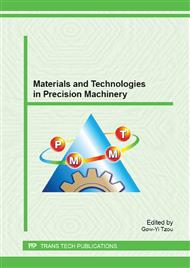p.16
p.22
p.29
p.36
p.44
p.55
p.62
p.69
p.77
Stress Analysis of Forging Dies for Inverse Extrusion
Abstract:
This study intended to investigate the longitudinal crack on the tungsten carbide alloy die core that caused by the influence of receiving the hoop tensile stress in the process of inverse extrusion. Therefore, the shrink fit is adopted to design the die core and stress ring, and assemble the die case, in order to yield the hoop compressive stress in advance, which can be used to resist the tensile hoop stress yielded from the forging process. It also applied the FEM simulation software and Taguchi Method L9(34) in this study to simulate various combinations of different shrink fits, in order to obtain the best combination of die. Moreover, it focused on the compressive strength of material characteristics for the tungsten carbide alloy steel die core, and properly adjusted the shrink fit to prevent an early crack on the die core that caused by the hoop compressive stress in advance, in order to achieve the best result.
Info:
Periodical:
Pages:
44-51
Citation:
Online since:
September 2015
Authors:
Keywords:
Price:
Сopyright:
© 2015 Trans Tech Publications Ltd. All Rights Reserved
Share:
Citation:


